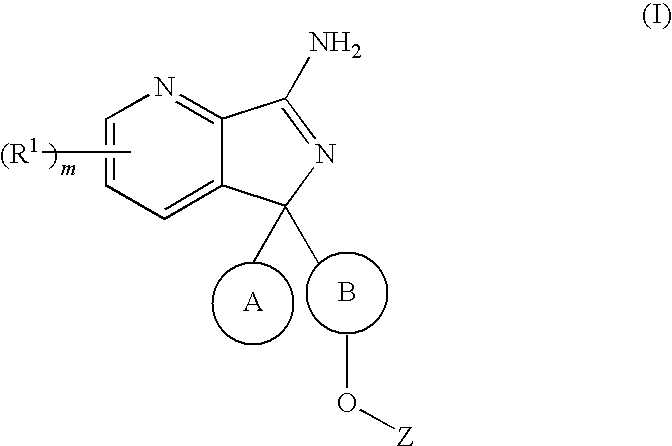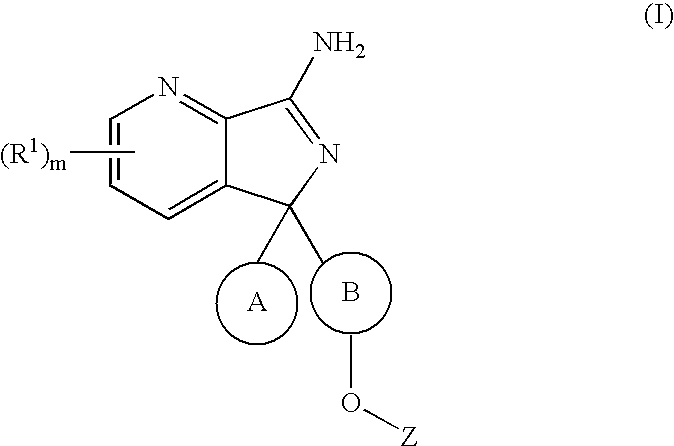New compounds 575
a technology of compounds and compounds, applied in the field of compounds, can solve the problems of high prevalence of alzheimer's disease in this population, increase in the number of patients with dementia, etc., and achieve the effect of slowing the progression of dementia and reducing the number of patients
- Summary
- Abstract
- Description
- Claims
- Application Information
AI Technical Summary
Benefits of technology
Problems solved by technology
Method used
Image
Examples
example 1i
3-(3-Fluoropropoxy)benzoic acid
[0172]
[0173]Methyl 3-hydroxybenzoate (10 g, 65.73 mmol), triphenylphosphine (18.96 g, 72.30 mmol) and 3-fluoropropan-1-ol (5.43 mL, 72.30 mmol) were dissolved in THF (100 mL) and cooled to 0° C. Diisopropyl azodicarboxylate (14.23 mL, 72.30 mmol) was added and the mixture was stirred at rt for 1 h. Water was added and the mixture was concentrated. Diethyl ether was added to the residue and the organic phase was washed with NaOH (2M) and brine, dried over MgSO4 and concentrated. The residue was dissolved in THF (50 mL). Sodium hydroxide (3M aq.) (54.8 mL, 164.31 mmol) was added and the mixture was heated to 50° C. for 2 h. The reaction mixture was washed with DCM and the water phase was acidified with. HCl (conc) until pH ˜2 and then extracted with DCM. The organic phase was dried over MgSO4, filtered and concentrated to give 12.8 g (98% yield) of the title compound:
[0174]1H NMR (500 MHz, DMSO-d6) δ ppm 2.06-2.17 (m, 2H) 4.12 (t, 2H) 4.57 (t, 1H) 4.66 (...
example 2i
3-(3-Fluoropropoxy)benzoyl chloride
[0175]
[0176]To a suspension of 3-(3-fluoropropoxy)benzoic acid (5.26 g, 26.54 mmol) in anhydrous dichloromethane (50 mL) was added oxalyl chloride (2.3 mL, 26.5 mmol), followed by addition of anhydrous DMF (0.5 mL). The reaction mixture was stirred at room temperature for 3 h and concentrated in vacuo to give the crude title compound in quantitative yield, which was used directly in the next step without further purification. An analytical sample was treated with methanol to generate 3-(3-fluoro-propoxy)-benzoic acid methyl ester:
[0177]MS (ES−) m / z 211 [M−H]−.
example 3i
3-(3-Methoxybenzoyl)picolinonitrile
[0178]
[0179]3-Bromopicolinonitrile (2.8 g, 15.30 mmol) in dry THF (50 mL) was added dropwise over 1.5 h to a bottle of Rieke® Zinc (50.0 mL, 38.25 mmol) under nitrogen atmosphere and stirred for 1 h at r.t. The reaction mixture was cooled to −20° C. and stirred for 22 h. The excess zinc was removed by decantation, and the solution was cooled to −20° C. CuCN (LiBr)2 (1M in THF) (15.30 mL, 15.30 mmol) was added to the solution. The reaction mixture was allowed to reach 0° C. and stirred for 30 min. The mixture was cooled to −40° C. and 3-methoxybenzoyl chloride (2.26 mL, 16.1 mmol) was added. The reaction mixture was allowed to reach r.t. over night. Aqueous NH4Cl (sat.) was added and the mixture was extracted with EtOAc. The organic phase was washed with NaHCO3 (sat.) and brine, dried over MgSO4 and concentrated. Column chromatography using a gradient of 0-40% EtOAc in n-heptane gave 2.2 g (60% yield) of the title compound:
[0180]1H NMR (500 MHz, DMS...
PUM
 Login to View More
Login to View More Abstract
Description
Claims
Application Information
 Login to View More
Login to View More - R&D
- Intellectual Property
- Life Sciences
- Materials
- Tech Scout
- Unparalleled Data Quality
- Higher Quality Content
- 60% Fewer Hallucinations
Browse by: Latest US Patents, China's latest patents, Technical Efficacy Thesaurus, Application Domain, Technology Topic, Popular Technical Reports.
© 2025 PatSnap. All rights reserved.Legal|Privacy policy|Modern Slavery Act Transparency Statement|Sitemap|About US| Contact US: help@patsnap.com



